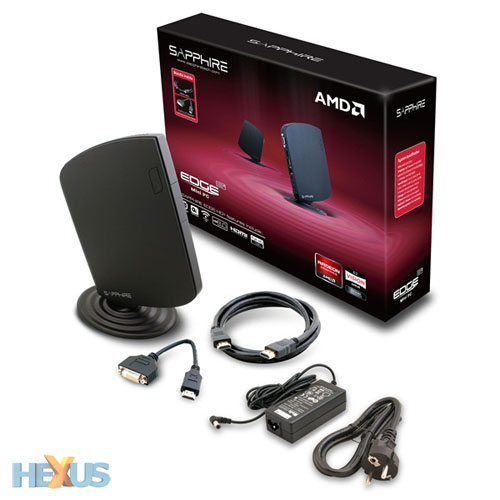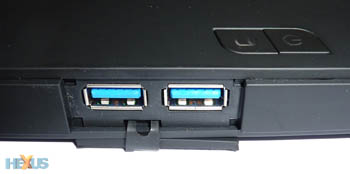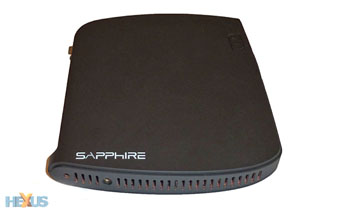What's new, pussycat?
Third time's the charm
Sapphire Technology stepped out of its AMD graphics comfort zone about a year ago with the launch of a tiny PC called the EDGE-HD. Presented in a form factor not much larger than a standard Blu-ray case and purporting to be a fully-functional PC, Sapphire chose to run with Intel's Atom processor and NVIDIA's ION 2 graphics. The choice seemed strange at first glance, as Sapphire's been a staunch AMD supporter for a while now. Indeed, we commented that "intrigued as we are by Sapphire's attempt to create a teeny-weeny bundle of geeky joy, we would hold fire until a Fusion version becomes available, and then take the pick of the two."
Sapphire subsequently boosted the specs in June 2011 and launched the EDGE-HD2. Equipped with Windows 7 OS and a faster Atom processor, the lack of AMD technology, specifically Brazos-based Fusion APUs, was telling. Sapphire, however, has finally jumped into bed with AMD (again) through the release of the third-generation EDGE-HD mini PC, now conveniently featuring said Brazos APU trickery.
Zacate has an EDGE
As a quick refresher, Brazos is AMD's low-power platform that uses up to two Bobcat CPU cores allied to integrated graphics that are on a par with the cheapest found on discrete cards. The clever trick here is to combine the CPU and GPU on to one die, hence the Fusion name. Brazos is further subdivided into three models: Desna (6W TDP), Ontario (9W TDP) and Zacate (18W TDP). Sapphire chooses the best-performing Zacate core, the E-450 model, for the innards to the EDGE-HD3.
The E-450 chip throws together a dual-core Bobcat CPU operating at 1.65GHz and a Radeon HD 6320 GPU that packs in 80 processing cores, with memory bandwidth pulled from the system's. The important point to remember is what the chip can do, more so than the on-paper specifications. The GPU portion provides basic games-playing clout and, perhaps more importantly, a helping hand when running all manner of high-definition video content. Point is, the E-450 chip should be better than the Atom/ION combination used on previous EDGE mini PCs.
Sapphire's keen to ensure there's minimal work required when updating the EDGE range. The chassis is the same as the original EDGE's - a fact made possible by the similarities between the thermal power demanded by Atom+ION and the E450 chip here (15W vs. 18W). As far as we can discern, the cooling is the same, too, with a large vent on the right-hand side used to exhaust the heat expelled by a 40mm fan.
Power and reset buttons remain on the top, but the update to AMD's E-450 chip has given Sapphire enough time to upgrade the two front-mounted ports to USB 3.0, as shown on the right.
Flick it around and, sensibly, Sapphire keeps the same ports arrangement, that is, VGA, the ever-useful HDMI, twin USB 2.0, Gigabit LAN and audio/mic ports. Inside, 802.11n WiFi compliments the Gigabit LAN, while general updates mean the 2.5in hard-drive is boosted from 250GB to 320GB and memory from 2GB to 4GB.
A peek at the smooth bottom of the chassis highlights a fact that may blight the chances of the EDGE-HD3 being considered for widespread adoption in office environments; there are no VESA mounts by which to attach it to a regular monitor for space-saving computing. Sure, the EDGE-HD3 isn't large, but it should be outfitted with an industry-standard VESA mount.

Sapphire includes a stand, HDMI-to-DVI adapter, HDMI cable, and the same 65W power-brick as on the original. Keeping costs somewhat in check, the £290 EDGE-HD3 is supplied with the FreeDOS operating system. Pre-configured Windows 7 is not offered as an option, though the relevant drivers are provided on a CD. Really, we'd prefer Sapphire include these on a USB stick instead, as many people installing Windows may not have a USB-powered optical drive to hand, or, like me, the patience to copy them over to a spare stick.
First-page summary
Now updated to support AMD's Fusion technology, Sapphire EDGE-HD3 sports the minimalist looks of the original version released last year. The current near-£300 price is a stumbling block, as a similarly-equipped, albeit not as small, Acer Revo RL70 can be purchased for £180.













